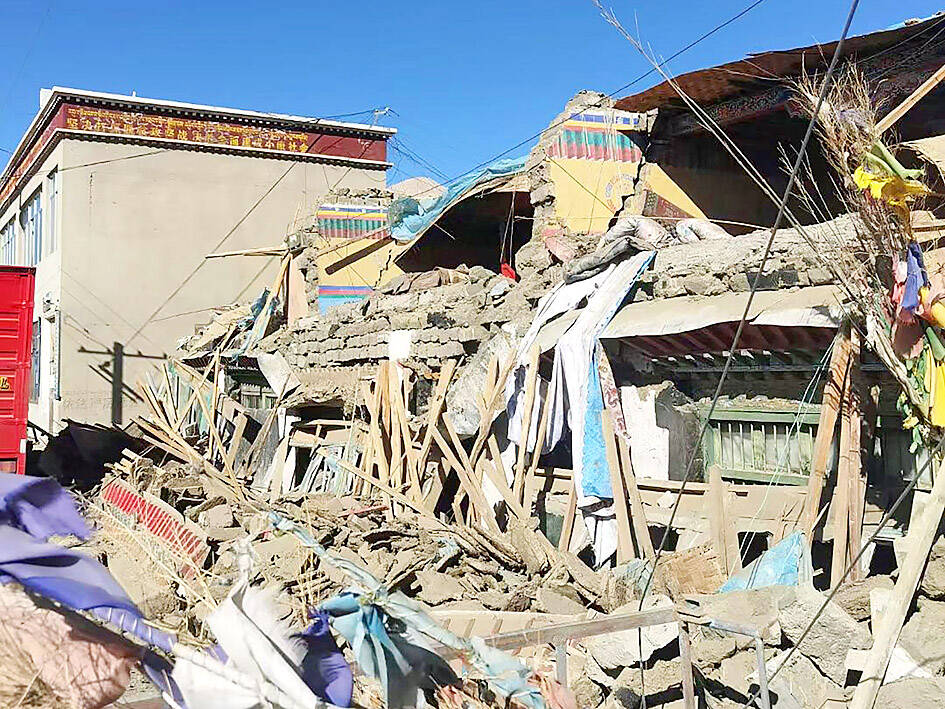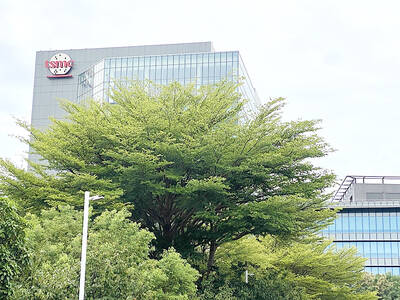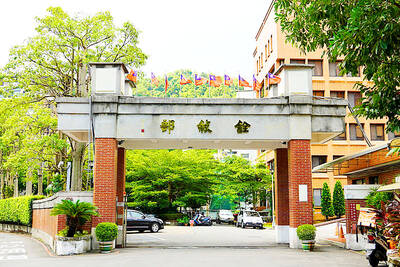A devastating earthquake in Tibet killed at least 95 people and collapsed “many buildings” yesterday, Chinese state media reported, with tremors also felt in neighboring Nepal’s capital, Kathmandu, and parts of India.
Videos published by state broadcaster China Central Television (CCTV) showed houses destroyed with walls torn apart.
Rescue workers waded through rubble strewn across the ruins in the aftermath, footage showed, while some gave locals thick blankets to keep warm in subzero temperatures.

Photo: AFP
The quake struck rural, high-altitude Tingri County, about 80km north of Mount Everest near China’s border with Nepal, at about 9am.
Sangji Dangzhi, whose supermarket in Tingri sustained considerable damage, described the situation as “very serious,” with ambulances taking people to hospital throughout the day.
“Here the houses are made from dirt so when the earthquake came ... lots of houses collapsed,” the 34-year-old said.
Surveillance images published by CCTV showed people running through a store’s aisles as shelves shook violently, sending objects like toys tumbling to the ground.
About 95 people had been confirmed dead and 130 others injured as of 3pm, Xinhua news agency said.
More than 1,000 houses have been damaged, it reported earlier.
The China Earthquake Networks Center (CENC) measured the quake’s magnitude as 6.8, while the US Geological Survey reported it as 7.1.
When tourist Meng Lingkang arrived in the town of Lhatse, 65km from the epicenter, where he had booked a restaurant, “the buildings had cracked open.”
“Some of the older houses collapsed, and a large part of the buildings made from bricks had cracked open, with big fissures,” the 23-year-old said.
Videos showed debris scattered in front of streetside eateries.
“There were quite a few [rescue vehicles]. One after the other they arrived,” Meng added.
The area most affected is surrounded by mountainous terrain on the Chinese side of Mount Everest.
Tingri, the epicenter, is home to about 62,000 people, and is much less developed than urban centers like Tibet’s capital, Lhasa.
Many of the fallen houses appeared to be constructed using traditional materials such as stone, mud bricks and wooden beams.
Chinese President Xi Jinping (習近平) has called for “all-out search and rescue efforts, minimizing casualties to the greatest extent possible, properly resettling affected residents, and ensuring their safety and warmth through the winter,” CCTV said.
Temperatures in Tingri are projected to drop to minus-16°C overnight, according to the Chinese Meteorological Administration.
In Taipei, President William Lai (賴清德) yesterday offered condolences to the families of those who died or were injured in the earthquake.
Lai on social media platform X wrote in English that “our thoughts are with the people of Tibet and the surrounding areas impacted by the devastating earthquake.”
“We extend our deepest condolences to the victims’ families, and we pray that rescue & aid efforts reach those in need to ensure a swift recovery,” he said.
The Mainland Affairs Council (MAC) expressed its condolences and concern for victims of the temblor.
The MAC in a statement said it sent the message of condolences to Chinese authorities through the cross-strait communication mechanism.
It said it has tasked the semi-official Straits Exchange Foundation with determining whether any Taiwanese were killed, injured or trapped by the earthquake.
Additional reporting by CNA

Taiwan Semiconductor Manufacturing Co (TSMC, 台積電) is expected to start construction of its 1.4-nanometer chip manufacturing facilities at the Central Taiwan Science Park (CTSP, 中部科學園區) as early as October, the Chinese-language Liberty Times (the Taipei Times’ sister newspaper) reported yesterday, citing the park administration. TSMC acquired land for the second phase of the park’s expansion in Taichung in June. Large cement, construction and facility engineering companies in central Taiwan have reportedly been receiving bids for TSMC-related projects, the report said. Supply-chain firms estimated that the business opportunities for engineering, equipment and materials supply, and back-end packaging and testing could reach as high as

CHAMPIONS: President Lai congratulated the players’ outstanding performance, cheering them for marking a new milestone in the nation’s baseball history Taiwan on Sunday won their first Little League Baseball World Series (LLBWS) title in 29 years, as Taipei’s Dong Yuan Elementary School defeated a team from Las Vegas 7-0 in the championship game in South Williamsport, Pennsylvania. It was Taiwan’s first championship in the annual tournament since 1996, ending a nearly three-decade drought. “It has been a very long time ... and we finally made it,” Taiwan manager Lai Min-nan (賴敏男) said after the game. Lai said he last managed a Dong Yuan team in at the South Williamsport in 2015, when they were eliminated after four games. “There is

Democratic nations should refrain from attending China’s upcoming large-scale military parade, which Beijing could use to sow discord among democracies, Mainland Affairs Council Deputy Minister Shen You-chung (沈有忠) said. China is scheduled to stage the parade on Wednesday next week to mark the 80th anniversary of Japan’s surrender in World War II. The event is expected to mobilize tens of thousands of participants and prominently showcase China’s military hardware. Speaking at a symposium in Taichung on Thursday, Shen said that Chinese Minister of Foreign Affairs Wang Yi (王毅) recently met with Indian Prime Minister Narendra Modi during a visit to New Delhi.

FINANCES: The KMT plan to halt pension cuts could bankrupt the pension fund years earlier, undermining intergenerational fairness, a Ministry of Civil Service report said The Chinese Nationalist Party (KMT) caucus’ proposal to amend the law to halt pension cuts for civil servants, teachers and military personnel could accelerate the depletion of the Public Service Pension Fund by four to five years, a Ministry of Civil Service report said. Legislative Speaker Han Kuo-yu (韓國瑜) on Aug. 14 said that the Act Governing Civil Servants’ Retirement, Discharge and Pensions (公務人員退休資遣撫卹法) should be amended, adding that changes could begin as soon as after Saturday’s recall and referendum. In a written report to the Legislative Yuan, the ministry said that the fund already faces a severe imbalance between revenue